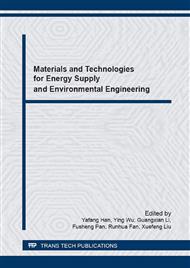p.456
p.460
p.466
p.472
p.479
p.485
p.490
p.497
p.505
Synthesis and Characterization Performance of a Novel High Temperature Retarder Applied in Long Cementing Interval
Abstract:
In view of the common polymer retarder of AMPS has poor sedimentation stability for slurry in high temperature, and thickening curve for unusual problems, a new terpolymers retarder PSIH which can solve the problem for the large temperature difference was synthesized by free radical aqueous solution copolymerization using styrene sulfonate (SSS), Itaconic acid (IA) and unsaturated hydroxyl ester monomers X . The structure and thermal stability of the copolymer was characterized with gel permeation chromatography (GPC), infrared spectroscopy (IR), and thermal gravimetric analysis (TG). The application performance of the retarder was assessed. The results demonstrated as follows. 1) The preferred synthesis conditions of the retarder is: the mass ratio of SSS/IA/X=9: 3: 1, temperature=60°C, initiator concentration =2%, the reaction time=5h, pH value was controlled in the neutral bias acidity. 2) Synthetic copolymer is the target product with appropriate molecular weight and has good thermal stability with thermal decomposition temperature of the main chain up to 375°C. 3) Compared with ordinary retarder the PSIH has merits as follows: excellent thermal resistant ability and sedimentation stability in high temperature; the rapid development of compressive strength in low temperature, and a big temperature span (30 °C~150 °C). The thickening time of the slurry with 1.0% PSIH is 245 min at 150°C; the compressive strength of cement with the same dosage can get up to 4.7MPa at 30 °C. In short, PSIH has excellent ability to cope with large temperature difference, providing a strong technical support for complex deep well cementing.
Info:
Periodical:
Pages:
479-484
Citation:
Online since:
March 2016
Authors:
Keywords:
Price:
Сopyright:
© 2016 Trans Tech Publications Ltd. All Rights Reserved
Share:
Citation:


